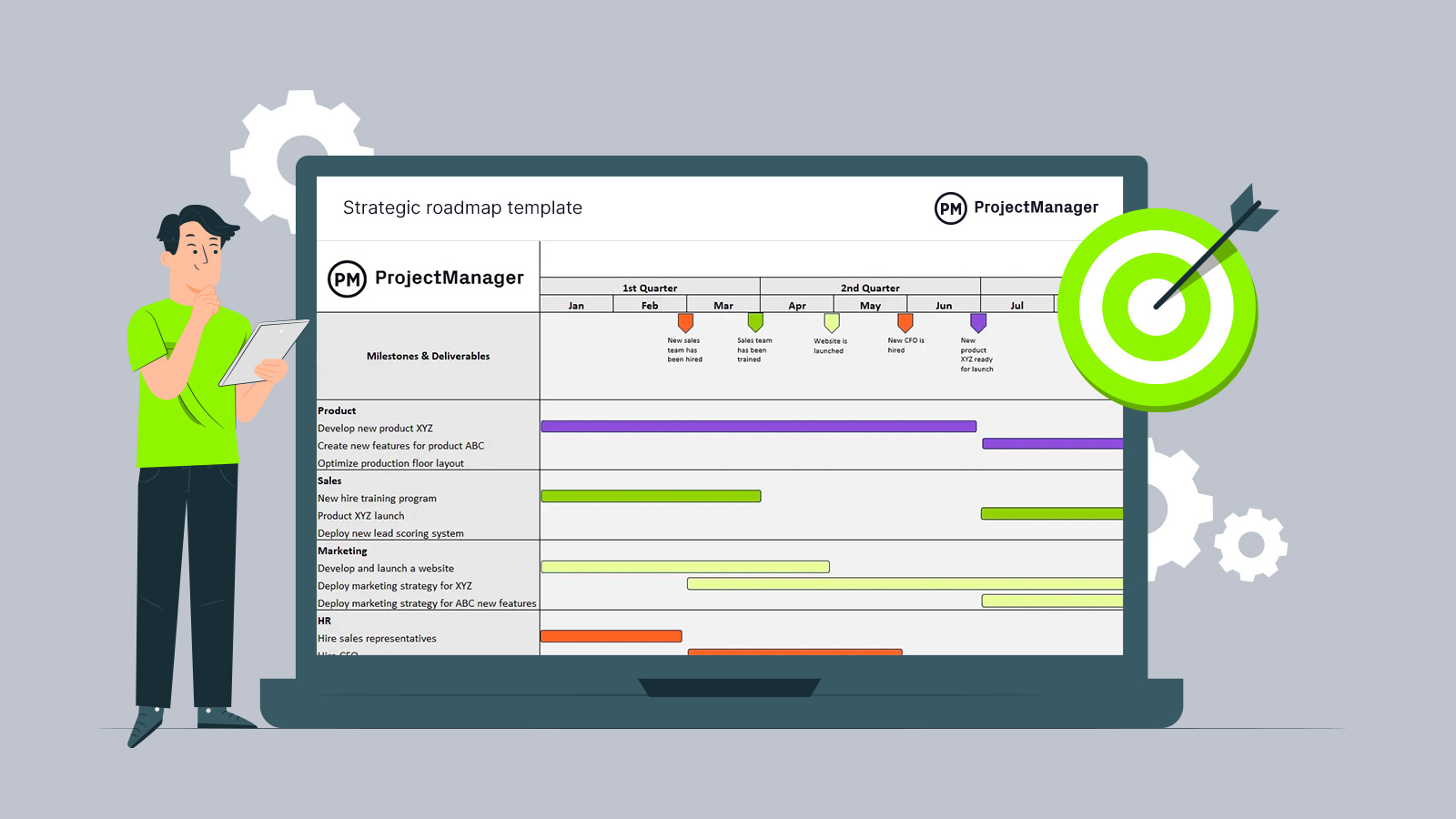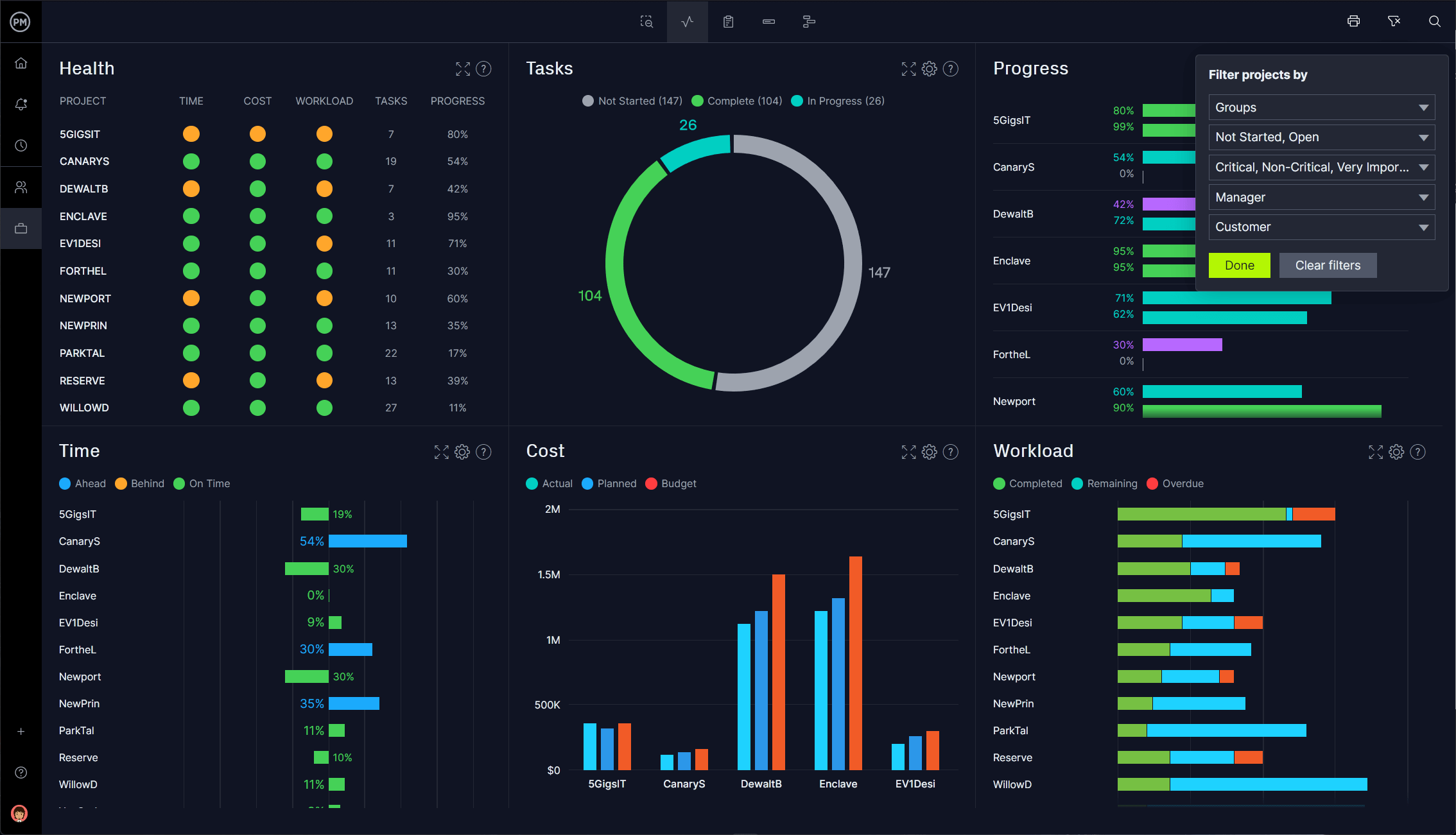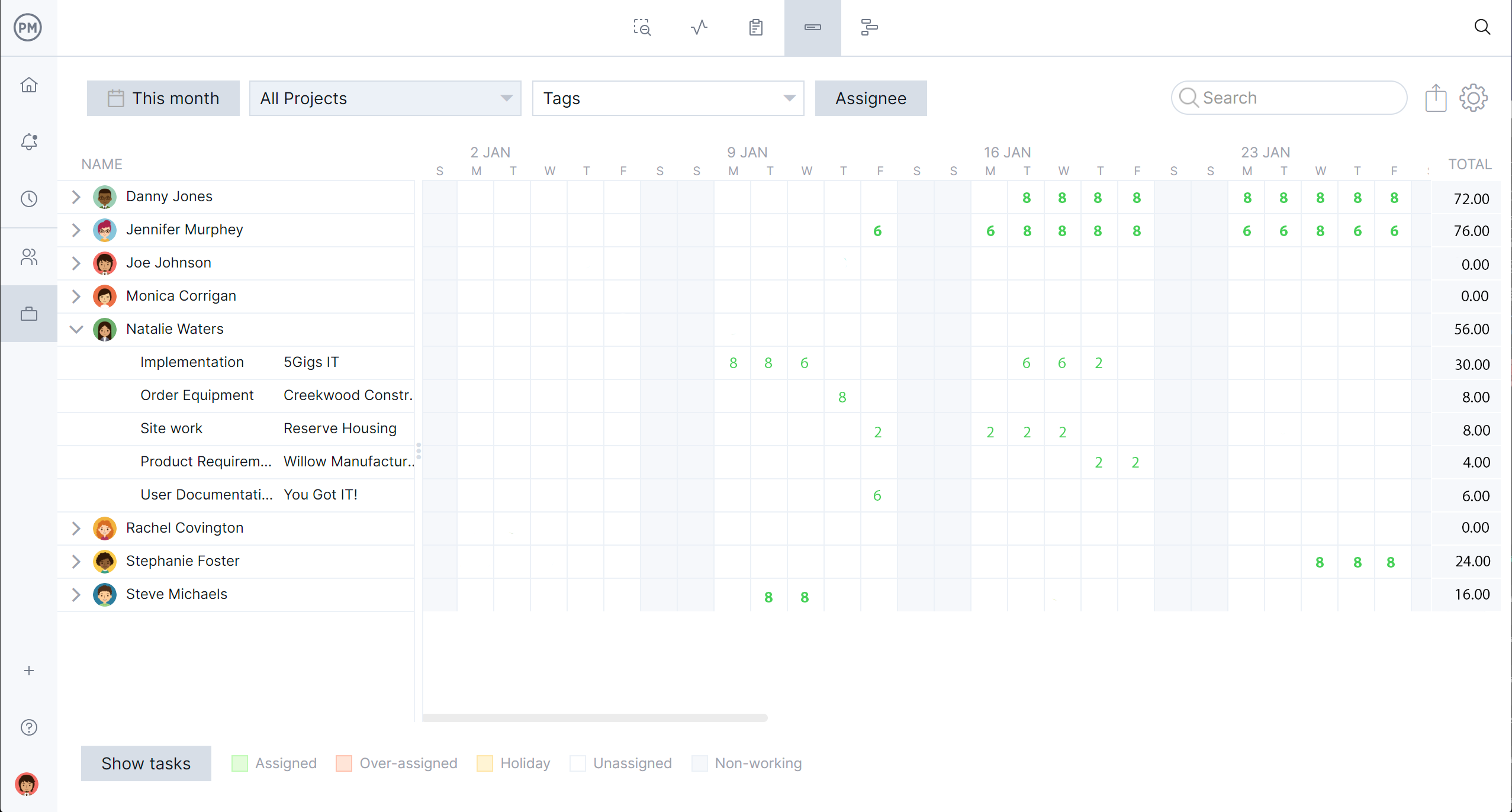The most successful companies always have one eye on the future so they can not only survive but thrive. That doesn’t happen without an organizational strategy to plan for the organization’s long-term success.
Organizational strategy has many layers. We’ll first define the term and then go into the organizational strategy levels, as well as explain its importance in business. Then we’ll detail the key components that make up a thorough organizational strategy and throw in some free templates to get you started.
What Is Organizational Strategy?
Organizational strategy is the long-term organizational planning a company does to operate and achieve its strategic goals in the future. It involves how the company will allocate its resources to support business activities that lead to achieving those long-term goals.
Another reason to have an organizational strategy is that it provides a roadmap that can be shared across the company and illustrates how those long-term goals will be met. It’s not only communicative but helps management develop strategic plans so the company can accomplish its goals.
ProjectManager is award-winning project and portfolio management software that has powerful roadmaps that help managers track their initiatives, allocate resources and ensure that they’re on track to meet their long-term plans. Our roadmap is a Gantt chart that visually represents all of your strategic goals and related projects, including the steps necessary to accomplish them.

Use our roadmap to tie your strategy to the work that must be completed to achieve your goals. You can group and organize your various projects, manage resources and generate reports to get valuable insights on your progress and performance. Get started with ProjectManager today for free.
Organizational Strategy Levels
Organizational strategy goes deep and a company can lay the groundwork for their strategy in many different areas. This is called organizational strategy levels. It’s something that must be thought through at the beginning of strategy creation or when a company is making a strategic plan. To do this successfully means understanding the three levels of strategy to align company goals from top to bottom. Let’s explore those three levels below.
Related: Free Strategic Planning Templates for Excel and Word
1. Corporate Level Strategy
The corporate-level strategy is the highest, which means it’s also the broadest. Leadership creates this multi-tiered company plan to define, outline and achieve specific goals. Smaller companies can use corporate-level strategies to increase profits, while larger companies with multiple divisions and businesses will have more complex corporate-level strategies, such as entering new markets.
Examples of Corporate-Level Strategies
Organizational strategy is all about finding the best way to allocate resources to meet long-term goals. Here are some examples of how that’s done on the corporate level.
- Diversification: When you want to expand your business, this strategy encourages growth by adding new products or services.
- Retrenchment: This is when you consider changing your business model and is used when taking protective measures to keep the solvency of your business.
- Profit: Here a company will outline plans to increase revenue while keeping costs down.
- Stability: When the company is doing well, it seeks incremental growth by working with clients in its industry.
2. Business Level Strategy
A business-level strategy is made up of the strategic planning and implementation activities that will direct the company’s business units. This is usually used to gain a competitive advantage and create customer value in the market where the business unit operates.
Examples of Business-Level Strategies
This level of organizational strategy creates roadmaps to guide resource allocation and aligns different departments with the goal of sustainable growth, profitability and long-term success.
- Cost Leadership: This involves offering products or services at a lower cost than competitors by improving facilities, investing in tools, reducing overhead, etc.
- Differentiation: Here the company focuses on developing and marketing products that provide greater value rather than cheaper costs for the customer.
- Focused Cost Leadership: This targets a niche market and narrows the focus, allowing the company to better understand customer needs.
- Focused Differentiation: Here companies want to stand out from the competition while focusing on a smaller subset of their customer base to better anticipate customer needs.
3. Functional Level Strategy
A functional-level strategy means that the actions and goals assigned to various company departments support both business and corporate-level strategies. These strategies specify the outcomes that the company’s business departments achieve through daily operations. Therefore, functional-level strategy means that the corporate-level strategy needs participation across departments. Each department manager is responsible for leading their teams on these initiatives.
Examples of Functional-Level Strategies
- Human Resources: This department seeks out and hires highly-trained employees to solidify the workforce.
- Marketing: Works toward improving brand identification through both paid and unpaid efforts.
- Finance: Various initiatives include reducing operational expenses or implementing a new budgeting system.
- Product: Helps to develop the product or service, working to create efficiencies.

Get your free
Strategic Roadmap Template
Use this free Strategic Roadmap Template for Excel to manage your projects better.
Importance of Your Business’ Organizational Strategy
Organizational strategy has many benefits. Without having a strategy to direct your company and its strategic initiatives, the chance of reaching whatever goals you’ve set for yourself is unlikely. Rather than bet on luck to achieve your long-term goals, an organizational strategy will have a far greater impact. Here are some reasons why.
Shapes the Structure of the Organization
Organizational strategy aligns companies to a singular goal by defining what departments and roles are needed in planning the organizational strategy of a business. This creates transparency in a company’s operations that assists with better resource allocation and decision-making.
Aligns the Efforts of All Areas of the Organization
Organizational strategy also aligns everyone in the company to the common strategic goal of the company. This not only puts everyone on the same page as to understanding what their target is, but all work processes will also align to make the individual work, department and entire company more efficient. You can use a strategic roadmap to map the activities that each department will execute to better understand how different initiatives across your company work together.
Defines How Your Business Will Operate
The functional aspect of organizational strategy refers to how each part of the business will operate. It also speaks to how the company will contribute to implementing the business-level strategies and accomplishing the long-term, strategic goals of the business.
Key Components of the Organizational Strategy of a Business
When you’re developing an organizational strategy, first you have to have an idea of where you want to see the company in the long term. This will lead to the actions that the company must take to get there. That’s just two components of how a business deals with its organizational strategy. Below are all the key components of an organizational strategy for a business.
- Mission & Vision: The mission of the company and its vision for the future of the company should be brief written statements focusing on customers, employees and investors and its aspirations for the future.
- Organizational Structure: Create a system that outlines how business activities are directed to achieve the long-term goals of the company, such as rules, roles and responsibilities.
- Organizational Change: These are the actions a company takes to alter a major component of its organization. This could be anything from its culture, underlying technology or infrastructure to its internal processes.
- Organizational Culture: This refers to how an organization conducts itself as a whole in a different way from how others do. For example, how meetings are run, how new hires are trained, communication, benefits, etc.
- Strategic Plan: Here’s where the sequence of steps are outlined that will lead to achieving the company’s vision or long-term goals and objectives.
- Tactical Plan: Breaks the strategic plan into smaller objectives and goals and how they will be achieved through actions.
- Operational Plan: This will break down the day-to-day activities of the company. It will be at the project, business unit, functional or departmental level. These plans are highly detailed and action-based.
Strategic Roadmap Template
This free strategic roadmap template helps you visualize the projects and initiatives that each business department in your organization will execute to contribute to the accomplishment of strategic goals.

Related Organizational Strategy Templates
There are many steps to creating and implementing an organizational strategy. The following free strategic planning templates can help you figure out what’s the best approach and then create a plan to help you achieve your long-term goals.
Organizational Chart Template
An organizational chart can help you define the roles and responsibilities of your organization, which is part of the larger organizational strategy. Our free organizational chart for Excel is a visual flowchart illustrating the internal structure of your company.
Strategic Plan Template
Use our free strategic plan template for Word to define your vision, mission and business goals. It will help you develop a marketing plan, if necessary, and an operational plan. There’s also space to define your team and financial projections.
SWOT Analysis Template
SWOT stands for strengths, weaknesses, opportunities and threats. Our free SWOT analysis template for Excel helps you evaluate each of these four things as they relate to your business. This will inform your organizational strategy.
How ProjectManager Helps Track Your Organizational Strategy
While these free templates are a great starting point for your organizational strategy, they’re only going to take you so far. They’re not going to be helpful when implementing the strategic plan. That’s because these are static documents that must be manually updated and aren’t useful for collaboration across the organization. Project management software connects your teams and makes executing your plan more efficient. ProjectManager is award-winning project and portfolio management software that has the portfolio features you need to plan, manage and track multiple projects.
Track Resource Usage Throughout Your Organization
Our roadmap tool allows you to plan and allocate resources across multiple projects and different departments in your company. When you onboard your teams, set their availability, including PTO, vacation time and global holidays for those teams that are working remotely. This makes assignments easier. Then check the color-coded workload chart to make sure no one is overallocated. If they are, you can balance their workload right from the chart to keep them working at capacity and productive.

Monitor Resources, Schedule and Budget in Real Time
Once you’ve made a plan, you’ll need to keep an eye on its progress and performance to ensure that it’s meeting your schedules and staying within your allocated resources. Get a high-level overview of all your projects in one place with our real-time portfolio dashboard. It collects live data automatically and displays it on easy-to-read graphs and charts. Now you can stay updated on time, costs, workload and more. Best of all, there’s no time-consuming and complicated setup as you’ll find with inferior alternatives. Whether using a project or portfolio dashboard, it’s ready when you are.

When you need more detailed information, use our customizable reporting features. You can get portfolio and status reports, as well as reports on variance, timesheets, workload and more. You can filter the reports as needed to show only the data you want to see. From there, share them with stakeholders in a variety of formats to keep them updated.
ProjectManager is online project and portfolio management software that connects teams whether they’re in the office, out in the field or anywhere in between. They can share files, comment at the task level and stay updated with email and in-app notifications. Join teams at Avis, Nestle and Siemens who use our software to deliver successful projects. Get started with ProjectManager today for free.


